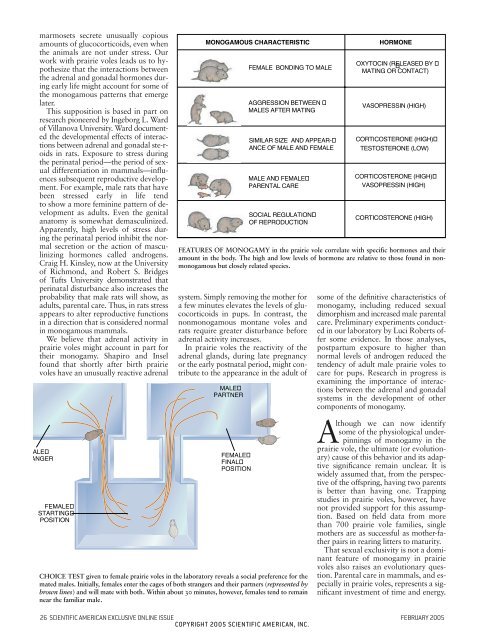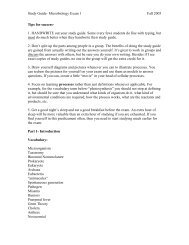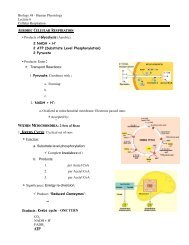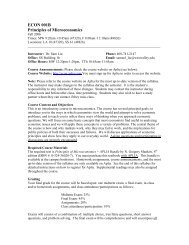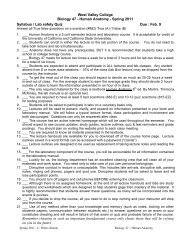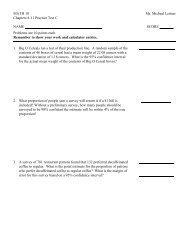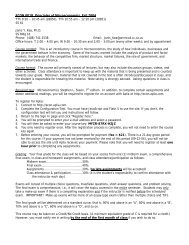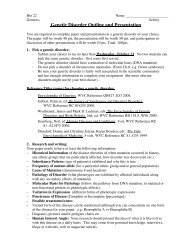Battle of the Sexes
Battle of the Sexes
Battle of the Sexes
You also want an ePaper? Increase the reach of your titles
YUMPU automatically turns print PDFs into web optimized ePapers that Google loves.
marmosets secrete unusually copious<br />
amounts <strong>of</strong> glucocorticoids, even when<br />
<strong>the</strong> animals are not under stress. Our<br />
work with prairie voles leads us to hypo<strong>the</strong>size<br />
that <strong>the</strong> interactions between<br />
<strong>the</strong> adrenal and gonadal hormones during<br />
early life might account for some <strong>of</strong><br />
<strong>the</strong> monogamous patterns that emerge<br />
later.<br />
This supposition is based in part on<br />
research pioneered by Ingeborg L. Ward<br />
<strong>of</strong> Villanova University. Ward documented<br />
<strong>the</strong> developmental effects <strong>of</strong> interactions<br />
between adrenal and gonadal ste-roids<br />
in rats. Exposure to stress during<br />
<strong>the</strong> perinatal period—<strong>the</strong> period <strong>of</strong> sexual<br />
differentiation in mammals—influences<br />
subsequent reproductive development.<br />
For example, male rats that have<br />
been stressed early in life tend<br />
to show a more feminine pattern <strong>of</strong> development<br />
as adults. Even <strong>the</strong> genital<br />
anatomy is somewhat demasculinized.<br />
Apparently, high levels <strong>of</strong> stress during<br />
<strong>the</strong> perinatal period inhibit <strong>the</strong> normal<br />
secretion or <strong>the</strong> action <strong>of</strong> masculinizing<br />
hormones called androgens.<br />
Craig H. Kinsley, now at <strong>the</strong> University<br />
<strong>of</strong> Richmond, and Robert S. Bridges<br />
<strong>of</strong> Tufts University demonstrated that<br />
perinatal disturbance also increases <strong>the</strong><br />
probability that male rats will show, as<br />
adults, parental care. Thus, in rats stress<br />
appears to alter reproductive functions<br />
in a direction that is considered normal<br />
in monogamous mammals.<br />
We believe that adrenal activity in<br />
prairie voles might account in part for<br />
<strong>the</strong>ir monogamy. Shapiro and Insel<br />
found that shortly after birth prairie<br />
voles have an unusually reactive adrenal<br />
ALE<br />
ANGER<br />
FEMALE<br />
STARTING<br />
POSITION<br />
MONOGAMOUS CHARACTERISTIC HORMONE<br />
system. Simply removing <strong>the</strong> mo<strong>the</strong>r for<br />
a few minutes elevates <strong>the</strong> levels <strong>of</strong> glucocorticoids<br />
in pups. In contrast, <strong>the</strong><br />
nonmonogamous montane voles and<br />
rats require greater disturbance before<br />
adrenal activity increases.<br />
In prairie voles <strong>the</strong> reactivity <strong>of</strong> <strong>the</strong><br />
adrenal glands, during late pregnancy<br />
or <strong>the</strong> early postnatal period, might contribute<br />
to <strong>the</strong> appearance in <strong>the</strong> adult <strong>of</strong><br />
MALE<br />
PARTNER<br />
FEMALE<br />
FINAL<br />
POSITION<br />
FEMALE BONDING TO MALE<br />
AGGRESSION BETWEEN<br />
MALES AFTER MATING<br />
SIMILAR SIZE AND APPEAR-<br />
ANCE OF MALE AND FEMALE<br />
MALE AND FEMALE<br />
PARENTAL CARE<br />
SOCIAL REGULATION<br />
OF REPRODUCTION<br />
CHOICE TEST given to female prairie voles in <strong>the</strong> laboratory reveals a social preference for <strong>the</strong><br />
mated males. Initially, females enter <strong>the</strong> cages <strong>of</strong> both strangers and <strong>the</strong>ir partners (represented by<br />
brown lines) and will mate with both. Within about 30 minutes, however, females tend to remain<br />
near <strong>the</strong> familiar male.<br />
OXYTOCIN (RELEASED BY<br />
MATING OR CONTACT)<br />
VASOPRESSIN (HIGH)<br />
CORTICOSTERONE (HIGH)<br />
TESTOSTERONE (LOW)<br />
CORTICOSTERONE (HIGH)<br />
VASOPRESSIN (HIGH)<br />
CORTICOSTERONE (HIGH)<br />
FEATURES OF MONOGAMY in <strong>the</strong> prairie vole correlate with specific hormones and <strong>the</strong>ir<br />
amount in <strong>the</strong> body. The high and low levels <strong>of</strong> hormone are relative to those found in nonmonogamous<br />
but closely related species.<br />
some <strong>of</strong> <strong>the</strong> definitive characteristics <strong>of</strong><br />
monogamy, including reduced sexual<br />
dimorphism and increased male parental<br />
care. Preliminary experiments conducted<br />
in our laboratory by Luci Roberts <strong>of</strong>fer<br />
some evidence. In those analyses,<br />
postpartum exposure to higher than<br />
normal levels <strong>of</strong> androgen reduced <strong>the</strong><br />
tendency <strong>of</strong> adult male prairie voles to<br />
care for pups. Research in progress is<br />
examining <strong>the</strong> importance <strong>of</strong> interactions<br />
between <strong>the</strong> adrenal and gonadal<br />
systems in <strong>the</strong> development <strong>of</strong> o<strong>the</strong>r<br />
components <strong>of</strong> monogamy.<br />
Although we can now identify<br />
some <strong>of</strong> <strong>the</strong> physiological underpinnings<br />
<strong>of</strong> monogamy in <strong>the</strong><br />
prairie vole, <strong>the</strong> ultimate (or evolutionary)<br />
cause <strong>of</strong> this behavior and its adaptive<br />
significance remain unclear. It is<br />
widely assumed that, from <strong>the</strong> perspective<br />
<strong>of</strong> <strong>the</strong> <strong>of</strong>fspring, having two parents<br />
is better than having one. Trapping<br />
studies in prairie voles, however, have<br />
not provided support for this assumption.<br />
Based on field data from more<br />
than 700 prairie vole families, single<br />
mo<strong>the</strong>rs are as successful as mo<strong>the</strong>r-fa<strong>the</strong>r<br />
pairs in rearing litters to maturity.<br />
That sexual exclusivity is not a dominant<br />
feature <strong>of</strong> monogamy in prairie<br />
voles also raises an evolutionary question.<br />
Parental care in mammals, and especially<br />
in prairie voles, represents a significant<br />
investment <strong>of</strong> time and energy.<br />
26 SCIENTIFIC AMERICAN EXCLUSIVE ONLINE ISSUE FEBRUARY 2005<br />
COPYRIGHT 2005 SCIENTIFIC AMERICAN, INC.


